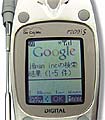Developing i-mode in America
Back to Contents of Issue: February 2001
|
|
|||
|
by Daniel Scuka |
|||
If you're like Mountain View, California-based search site Google, whose i-mode compatible search engine was in beta as of mid-December, you'll go out to the developer community and ask fellow wireless gurus on this side of the Pacific to give it a whirl. In a message addressed to "Google Friends," the company offered a free T-shirt to anyone reporting a bug. Character and animation development house Animobile, headquartered in Glendale, California, has a tougher problem, since the appearance of the graphics on the keitai screen must be carefully controlled. As any wireless developer here can attest, screen behavior varies considerably from phone to phone. Chris Young, chief creative office at Animobile, said that the firm was working with a number of developers in Japan for its initial testing, while the servers are located in the US. Animobile's US and Japan engineers go live on instant messaging, and spend several hours each day tweaking the screens' appearance in a laborious, back-and-forth operation. Don't blame DoCoMo or the other network operators for the lack of effective PC-based emulators. Many developers point to the makers' individual implementations of the microbrowser supplied by Access (see page 10, June 2000, for more on Access), as well as minor hardware differences, as the source of testing frustration. Besides, most of the emulators available work only in Japanese. We think that's going to change. Links |
|||
Note: The function "email this page" is currently not supported for this page.







